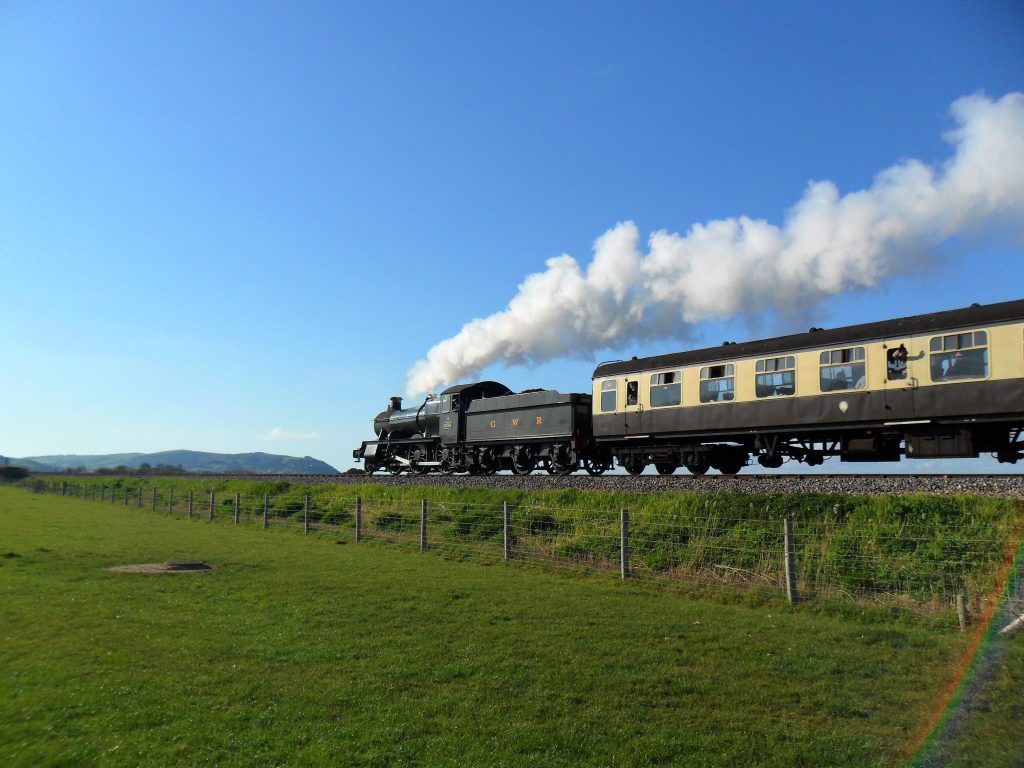WEST SOMERSET RAILWAY

The West Somerset Railway is known as England’s longest heritage railway, with steam trains puffing over 20 miles from Minehead to Bishop’s Lydeard, along the Bristol Channel Coast. The history of the line began when Bristol and Exeter Railway made its way southwards in the 1840s and 50s, as an extension of Isambard Kingdom Brunel’s original Great Western line.
After being promoted by local business men, the railway continued to be extended and the project was taken on by Brunel’s assistant James Burke, who continued the line over a range of hills – the Quantocks. The railway was then extended to Minehead in 1874, which helped to transform it into the holiday resort town it is today. While the line ran for nearly 100 years, it was sadly closed in 1971 due to lack of finances.
Services started up again in 1979, and the company hired the last steam engine, ‘Evening Star’, built for British Railways in 1989. Now a heritage railway, the service carries over 200,000 passengers a year, making it a popular attraction loved by locals and visitors alike.
In order to keep the service running smoothly, there are on-going repairs on some of the steam locomotives –the GWR 7800 ‘Manor’ re-entered service in December 2018 following boiler repairs. The West Somerset Railway continues to preserve beloved steam trains and locomotives, whilst also offering a high quality service for those who use the railway.
A unique and enjoyable experience
The majestic steam train, with its exquisite carriages, provides luxurious comfort and stunning views across Somerset. What the journey lacks in speed, it makes up for with charm, as the peaceful route carries you from historical village to seaside town.
The antique carriage doorways enable you to re-enact your favourite period drama by waving out the window at passers-by, while the plush velvet seat coverings of each booth transport you to a different time completely. Hearing the churning of the locomotives wheels and the steady puffing of smoke creates a special atmosphere.
It is the standout views however, that really makes this journey. Travelling through the Quantocks is a sublime setting that allows each guest to get lost in the scenery and enjoy a moment of tranquillity. When experienced from the comfort of a steam train, the views transport you to a bygone era, with time to relax and enjoy your surroundings.
Overall, travelling on the West Somerset Railway line is as beautiful as it is fun. With nine stops along the way, there are plenty of places to hop off and enjoy the surrounding heritage, and this article will showcase each stop and its highlights.
Choose your stop
Minehead
Added as a station in 1874, Minehead was developed by local businessmen into the holiday resort town it is today, attracting families from across the country. With the station located on the main high street, just a short walk from the seafront, there is plenty to see and do within walking distance. Sun-worshippers can enjoy the beach, while those with young children will appreciate the amusement arcade and Butlin’s holiday park. Blenheim Gardens provides a peaceful space, where visitors can enjoy the landscaped gardens free of charge.
The station’s own Buffer Stop Shop stocks a wide range of specialist books, magazines and DVDs about the West Somerset Railway, as well as other merchandise such as fleece jackets and postcards. With a variety of different activities and places of interest, Minehead is the perfect day out for any family.
Dunster
Following Minehead, the historic village of Dunster is often thought of as the best preserved medieval village in West Somerset. A 20-minute walk from the station, this charming settlement has much to offer, with Dunster Castle its standout attraction. Now in the care of the National Trust, this Norman motte and bailey fortress has endured much of the past, having survived anarchy in the 12th century. With stunning views over the whole area, this site is not to be missed – and West Somerset Railway ticket holders can enjoy a 20% discount on the entrance fee.
Retaining the rustic charm of the past, the village itself is quaint but vibrant, with a medieval yarn market and several classic pubs. In addition, there are various walks around the area with gorgeous views. A favourite of many is the walk through the woods to Bat’s Castle, a prehistoric site that provides views across the Bristol Channel as far as South Wales.
Blue Anchor
Blue Anchor is a peaceful seaside village with a sweeping sand and shingle beach. The area is ideal for families and dog owners, as dogs are permitted on the beach with or without a lead. There are also a few fantastic food outlets, most notably the Driftwood Café which serves an amazing array of freshly sourced dishes throughout the day. The station also houses a small museum dedicated to the Great Western Railway, which is open on Sundays and Bank Holiday Mondays. The stunning seaside is increasingly popular with visitors, thanks to the vast stretch of beach and range of accommodation on offer.
Washford
Washford is a quaint village only a short journey from neighbouring town Watchet. The village itself boasts a grand Abbey, which is located just a few minutes’ walk from the station. Cleeve Abbey, now administered by English Heritage, is open throughout the high season from 1 April until 31 October. The surrounding ruins offer an idea of monastic life, while the rest of Washford has an alluring charm. The Somerset and Dorset Railway Trust Museum holds many relics from the former joint railway which closed in 1966. The Torre cider farm is also situated just a short walk from the station, and offers visitors the chance to learn about local cider production.
Watchet
This ancient harbour town is colourful in every sense of the world. With a history spanning over 1000 years, there is more to this fishing town than meets the eye. Watchet harbour was once the inspiration for the epic poem The Ancient Mariner by romantic poet Samuel Taylor Coleridge. There is now a seven-foot high statue of the mariner, created by artist Alan Herriot that sits on the harbour front. The extensive history of the town is documented in the local Boat Museum, which also includes information on the West Somerset Mineral Railway that would’ve supplied the town with iron. The array of fantastic shops and restaurants bring a lively atmosphere to the charismatic seaside town.
Williton
While Williton Station has been carefully preserved from the time the line was open, the main town is an interesting combination of modern houses with older cottages. The friendly village is home to food stores, a police station and a cottage hospital. There are numerous charity shops, along with the Williton Social Club and the head offices of The West Somerset Free Press. The village boasts a modern library, various pubs and the Bakelite Museum, which houses a brilliant collection of items from the plastics revolution. Located a half an hour walk away from the station, the museum also has a lovely tearoom for visitors to enjoy an afternoon treat. Williton is a fantastic place to visit, with excellent local amenities and a unique community spirit.
Stogumber
This next stop is a chocolate box village in between the Quantock and Brendon Hills. The beautiful St. Mary’s Norman church sits at the centre of the community, with its intricate William Morris style ceiling. A lovely place to stop by and wander around, Stogumber is a peaceful and picturesque village.
Crowcombe Heathfield
Crowcombe Heathfield is the perfect place to enjoy the countryside. The station acts as a great starting and end point for a walk on the Quantock Hills, or for cycling down country lanes. However you chose to spend your time in Crowcombe Heathfield, the area offers unrivalled views which any visitor would fall in love with.
Bishop’s Lydeard
The final stop on the line (if you’re travelling from Minehead) is the village of Bishop’s Lydeard, which is near the market town of Taunton, and comprised of a mixture of red sandstone and brick buildings. There are a variety of historical sites for visitors to enjoy. A short walk from the station takes you to the village watermill, a fully restored and working water wheel. Alongside the wheelwright and blacksmith’s shop, is the St. Mary the Virgin church which dates back to the early 14th century – inside are some beautiful wood carvings, as well as the village charter from 1291.
This exciting village houses the Quantock Brewery, a family run business featuring a taproom where visitors can sample beers, as well as a brewery shop selling beer made using traditional craft techniques. The Cedar Falls Health Farm and Quantock Hills are also nearby and provide fantastic days out for all the family. As the last (or first) stop in the line, this village is rife for exploring, with its many treasures and places of interest.
Book your adventure
To fully immerse in the experience, the train can be caught from either Bishop’s Lydeard – on Station Road – or in Minehead on Warren Road. Tickets can be bought in advance, or on the day. Adult and senior tickets are £25.76 in advance or £28.00 on the day, with young person (ages 5 to 17) tickets prices £12.88 in advance or £14.00 on the day. Children under five travel for free. Disabled tickets are £21.00 and family day tickets offer an excellent discount at£62.56 in advance and £68.00 on the day. If you are traveling with your dog, or a bike you will pay an additional £3.00 on your ticket price.
The first service of the day departs at 10:20am from Bishop’s Lydeard and 10:10am from Minehead. Final departures are at 4:30pm. With such a variety of places to explore, the West Somerset Railway is an amazing and unforgettable day out.

